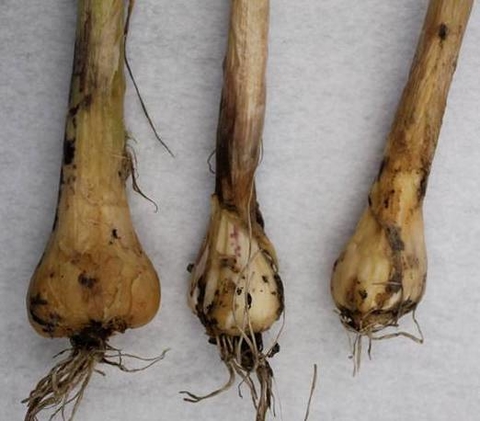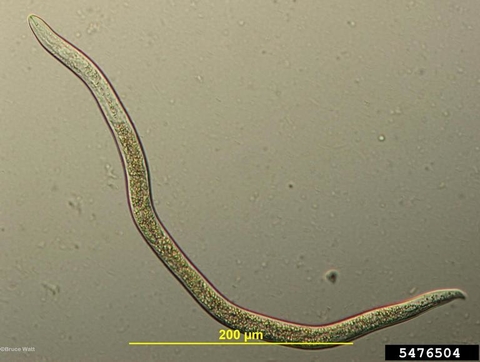Quick facts
- Stem and bulb nematode is an invasive pest that has been found in some areas of Minnesota.
- Leaves of infected plants turn yellow and bulbs become distorted or shrivel.
- Stem and bulb nematode can be introduced to a field on infected seed, contaminated soil or tools.
- The nematode can survive many years in plant debris, soil and on weed hosts.
- Nematodes can reproduce rapidly and cause significant yield loss.
- Plant clean seed, clean tools between fields, use crop rotation and plant green manure to manage stem and bulb nematode.
How to identify stem and bulb nematode
The University of Minnesota Plant Disease Diagnostic Clinic can test seed, plants and field soil for the presence of Ditylenchus dipsaci, the stem and bulb nematode. Contact the clinic for more information about how to send a sample.
Symptoms
- Leaves turn yellow, wilt and collapse.
- Plants may be stunted or die back prematurely.
- Infected plants are often clustered together, resulting in one or more distinct patches of discolored plants.
- Garlic bulbs turn brown, shrivel and become light weight.
- Wrapper layers often crack and become detached from the basal plate of the bulb.
- Onion leaves have swollen, distorted, blister like areas.
- Onion bulbs are brown and soft on some layers when cut open.
- Secondary organisms may cause extensive rot within the bulbs.
- Bulb damage can progress in storage.
Plants affected by stem and bulb nematode
The stem and bulb nematode, Ditylenchus dipsaci, can infect over 450 genera of plants. Most races of the nematode primarily infect a limited number of plants. The race of stem and bulb nematode that infects garlic also infects onion, chive, leek, celery, parsley, salsify, shasta pea, hairy nightshade and miner's lettuce.
How do stem and bulb nematodes survive and spread?
Although not widely distributed throughout Minnesota, stem and bulb nematodes can be introduced to a field on infected seed, plant debris, soil or water.
The nematodes live and feed within plant leaves, stems and bulbs. Nematodes enter plants by:
- Penetrating young plant tissue below ground.
- Climbing through films of water on the plant stem and entering through stomates, which are the natural openings within leaves.
Multiple generations of nematodes live within a plant. They migrate to soil only when the plant becomes so degraded that it’s no longer suitable for nematode feeding and reproduction.
Life cycle
Stem and bulb nematode populations can increase dramatically over a growing season.
- Female nematodes lay 8-10 eggs a day for 25-50 days (a total of 200-500 eggs per female).
- Eggs hatch into a juvenile nematode which looks similar to the adult nematode.
- The nematode goes through four molts before becoming a reproductive adult.
- A nematode can go from egg to maturity in about 20 days at 60 F.
- Mature nematodes live for 43-73 days.
Stem and bulb nematodes can survive on weeds or volunteer crop plants during crop rotation. They can also survive multiple years in a desiccated (dried out) state in plant debris, seed and soil. These desiccated nematodes rehydrate and infect a new crop in the presence of moisture.
How to manage stem and bulb nematode
Plant only clean, nematode free seed.
Do not move soil or plants from infested fields
If stem and bulb nematode is identified in a field, use strict sanitation procedures to prevent further spread of the pathogen.
- Clean all tools and equipment on site after working in an infested field.
- Do not use garlic from an infested field for seed. Even healthy looking bulbs may be infested with a small number of nematodes.
- Infested seed can be sold for food if damage doesn’t make the product unmarketable.
- Nematodes survive in infested bulbs and wrappers. Don’t bury culls in the field. Don’t move culls or crop debris to a new area.
Practice crop rotation
Rotate out of garlic for four years. Carrots, potatoes, spinach, corn and wheat are good choices for rotation crops because they are poor hosts for stem and bulb nematode. Control weeds and volunteers during rotations.
Use green manure
Mustard, rapeseed, oilseed, radish and sorghum-sudangrass can be used as a green manure. When tilled into the soil, these crops release compounds toxic to nematodes. Use of green manure has been shown to reduce nematode populations in other crops.
Don't use hot water treatment for garlic
Hot water treatments were recommended in the past to kill nematodes in infested garlic seed. Unfortunately, this treatment only reduces the number of nematodes in seed and doesn’t completely eliminate them. Increasing the temperature or duration of the treatment damages the garlic seed. This treatment is no longer recommended.
Reviewed in 2019



